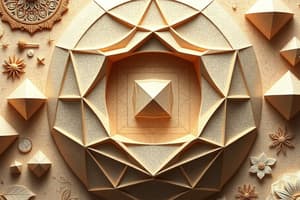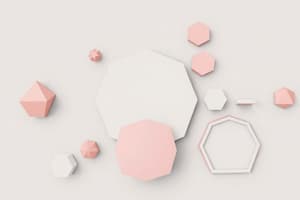Podcast
Questions and Answers
A carpenter is designing a storage shed. Which consideration is MOST crucial when deciding between using primarily two-dimensional shapes versus three-dimensional shapes in the shed's construction?
A carpenter is designing a storage shed. Which consideration is MOST crucial when deciding between using primarily two-dimensional shapes versus three-dimensional shapes in the shed's construction?
- The load-bearing capacity and space utilization, as 3D shapes generally offer greater structural integrity and storage volume. (correct)
- The aesthetic appeal of the shapes, as 2D shapes offer more visual variety.
- The ease of cutting and assembling the materials, as 2D shapes are simpler to work with.
- The cost of materials, since 2D shapes require less material than 3D shapes.
A graphic designer is creating a logo that needs to convey both simplicity and depth. What is the MOST effective approach using basic shapes to achieve this?
A graphic designer is creating a logo that needs to convey both simplicity and depth. What is the MOST effective approach using basic shapes to achieve this?
- Use simple 2D shapes arranged to suggest a 3D form or depth through techniques like layering or perspective. (correct)
- Use only circles and squares, as these are universally recognized and easily scalable.
- Combine several complex 2D shapes with varying colors to create an intricate design.
- Rely solely on 3D rendering software to generate a realistic looking three-dimensional logo.
An architect is designing a modern art museum. They want to incorporate shapes that challenge conventional expectations. Which strategy would BEST achieve this goal?
An architect is designing a modern art museum. They want to incorporate shapes that challenge conventional expectations. Which strategy would BEST achieve this goal?
- Combine and transform basic shapes in unconventional ways, such as intersecting or deforming them, to create unexpected forms and spaces. (correct)
- Primarily use rectangles and triangles to create a sense of stability and order.
- Focus on using vibrant colors to distract from the shapes themselves.
- Exclusively use spheres and cylinders for their smooth, easily accessible forms.
A company is developing a new line of packaging for their products. They want to minimize material waste while maximizing the perceived volume of the package. Which approach is MOST effective?
A company is developing a new line of packaging for their products. They want to minimize material waste while maximizing the perceived volume of the package. Which approach is MOST effective?
A sculptor is creating an abstract piece by combining basic geometric forms. They start with a solid cube of metal and then remove a cone from its center. How does this transformation affect both the surface area and volume of the original cube?
A sculptor is creating an abstract piece by combining basic geometric forms. They start with a solid cube of metal and then remove a cone from its center. How does this transformation affect both the surface area and volume of the original cube?
Flashcards
What are 2D Shapes?
What are 2D Shapes?
Shapes with only length and width.
What are 3D Shapes?
What are 3D Shapes?
Shapes with length, width, and height.
What is Classifying Shapes?
What is Classifying Shapes?
Sorting shapes into groups based on their attributes.
What is Comparing Shapes?
What is Comparing Shapes?
Signup and view all the flashcards
Shape Combination & Transformation
Shape Combination & Transformation
Signup and view all the flashcards
Study Notes
- Two-dimensional (2D) shapes are flat shapes that only have two dimensions: length and width
- Three-dimensional (3D) shapes have three dimensions: length, width, and height (or depth)
Properties of 2D Shapes
- 2D shapes are also known as plane shapes
- They can be described by their sides, angles, and vertices (corners)
- Sides can be straight or curved
- Polygons are 2D shapes with straight sides
- Examples include triangles, squares, pentagons, and hexagons
- Circles have a curved side and no vertices
Properties of 3D Shapes
- 3D shapes are also known as solid shapes
- They can be described by their faces, edges, and vertices
- A face is a flat surface of a 3D shape
- An edge is a line segment where two faces meet
- A vertex is a point where three or more edges meet
- Examples of 3D shapes include cubes, spheres, cones, cylinders, and pyramids
Classifying 2D Shapes
- 2D shapes can be classified based on their properties, such as the number of sides, the length of sides, and the size of angles
- Triangles can be classified by their sides:
- Equilateral triangles have three equal sides and three equal angles (60 degrees each)
- Isosceles triangles have two equal sides and two equal angles
- Scalene triangles have no equal sides and no equal angles
- Triangles can also be classified by their angles:
- Acute triangles have three acute angles (less than 90 degrees)
- Right triangles have one right angle (90 degrees)
- Obtuse triangles have one obtuse angle (greater than 90 degrees)
- Quadrilaterals are four-sided polygons
- Squares have four equal sides and four right angles
- Rectangles have four right angles, with opposite sides equal
- Parallelograms have two pairs of parallel sides, with opposite sides equal and opposite angles equal
- Rhombuses have four equal sides and opposite angles equal
- Trapezoids have at least one pair of parallel sides
- Polygons with more sides are named according to the number of sides (e.g., pentagon - 5 sides, hexagon - 6 sides, octagon - 8 sides)
- Regular polygons have all sides and all angles equal
- Irregular polygons have sides and angles that are not all equal
Classifying 3D Shapes
- 3D shapes can be classified into:
- Polyhedra: 3D Shapes with flat faces
- Non-polyhedra: 3D Shapes with curved surfaces
- Polyhedra include:
- Prisms: Two parallel identical bases connected by rectangular faces
- Cubes are prisms with six square faces
- Rectangular prisms have six rectangular faces
- Triangular prisms have two triangular faces and three rectangular faces
- Pyramids: A base and triangular faces that meet at a common vertex
- Square pyramids have a square base and four triangular faces
- Triangular pyramids have a triangular base and three triangular faces (also known as tetrahedrons)
- Prisms: Two parallel identical bases connected by rectangular faces
- Non-polyhedra shapes:
- Spheres: Perfectly round shapes with all points on the surface equidistant from the center
- Cylinders: Two parallel circular bases connected by a curved surface
- Cones: A circular base and a curved surface that tapers to a vertex
Comparing 2D Shapes
- Shapes can be compared based on their attributes and properties
- Number of sides and angles is an attribute that can be used to compare shapes
- The length of sides and angle measurements can also be used to compare shapes
- Symmetry is another way to compare shapes
- A shape has line symmetry if it can be folded along a line so that the two halves match exactly
- A shape has rotational symmetry if it can be rotated less than a full turn and still look the same
- Congruent shapes are identical -- same size and shape
- Similar shapes have the same shape, but different sizes
- Corresponding angles are equal
- Corresponding sides are in proportion
Comparing 3D Shapes
- 3D shapes can be compared based on the number of faces, edges, and vertices
- Shapes can also be compared based on their volume (the amount of space they occupy) and surface area (the total area of all their faces)
- Symmetry can also be used to compare 3D shapes
- 3D shapes can have plane symmetry (a plane that divides the shape into two identical halves) or rotational symmetry (an axis around which the shape can be rotated to look the same)
- Similar 3D shapes have the same shape but different size
- The volumes of similar figures are related by the cube of the ratio of the side lengths
Combining 2D Shapes
- 2D shapes can be combined to create new shapes
- Combining two triangles can create a square, parallelogram, or other quadrilaterals
- Combining rectangles can create larger rectangles, L-shapes, or other polygons
- Tessellations occur when shapes fit together in a repeating pattern with no gaps or overlaps
Combining 3D Shapes
- 3D shapes can be combined to create new and more complex forms
- Combining a cube and a pyramid can create a house-like shape
- Combining cylinders and hemispheres can create capsules or tanks
- Combining multiple cubes can create rectangular prisms
- Many real-world objects are made up of combinations of basic 3D shapes
Transforming 2D Shapes
- Transformations are ways to change the position or orientation of a shape
- Translations (slides): move a shape without changing its size, shape, or orientation
- Rotations (turns): spin a shape around a fixed point
- Reflections (flips): create a mirror image of a shape across a line
- Dilations (scaling): enlarge or reduce the size of a shape
Transforming 3D Shapes
- Transformations can also be applied to 3D shapes
- Translations, rotations, and reflections work similarly for 3D shapes as they do for 2D shapes
- Scaling involves changing the size of the 3D shape while maintaining its proportions
- Stretching or compressing a 3D shape can change its dimensions in one or more directions
Relationships between 2D and 3D shapes
- 2D shapes can be used to create 3D shapes through folding or extrusion
- A net is a 2D pattern that can be folded to form a 3D shape
- 3D shapes can be represented in 2D through projections (e.g., orthographic projections, perspective drawings)
- Cross-sections are 2D shapes that are revealed when a 3D shape is sliced
Studying That Suits You
Use AI to generate personalized quizzes and flashcards to suit your learning preferences.




